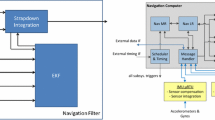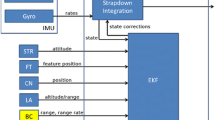Abstract
Precise and safe landings on celestial bodies as the Moon are needed for the further exploration and potential future exploitation of solar system bodies. The current navigation systems for landing probes are based on sensor data fusion of inertial and optical sensor measurements to determine the current flight state with respect to the target body and the desired landing site. To improve the accuracy of lunar landing navigation, radiometric measurements (range and range-rate) with respect to an orbiting vehicle have been proposed in several studies. This paper analyzes the impact of range and range-rate measurements from an orbiting vehicle on the navigation accuracy. For that purpose, a baseline configuration of an optical navigation system is used which has already been taken as a reference for investigating the effect of ground-based beacons. First, the influence of the orbiter trajectory in relation to the landing trajectory is investigated. In particular, the line of sight between orbiter and lander permits a preliminary assessment of the navigation performance. Later, the effects of sensor noise for all measurements and of the orbiter ephemeris error are also evaluated. Finally, for a selected scenario, it is demonstrated that radiometric measurements with respect to an orbiter can reduce the positioning error by about 40%.





Similar content being viewed by others
Notes
The origin is the Moon’s center, the first axis points to the mean prime meridian, the third axis to the North Pole, and the second axis to form a right-handed frame.
The origin is the Moon’s center, the third axis points to the radial direction to the lander, the second axis points to the direction given by the cross product between the position and velocity vectors of the lander, the first axis to form a right-handed frame.
References
Capuano, V., Blunt, P., Botteron, C., Tian, J., Léclere, J., Wang, Y., Basile, F., Farine, P.: Standalone GPS L1 C/A receiver for lunar missions. Sensors 16(3), 347–367 (2016)
Circi, C., Condoleo, E., Ortore, E.: A vectorial approach to determine frozen orbital conditions. Celest. Mech. Dyn. Astron. 128(2–3), 361–382 (2017)
Circi, C., Romagnoli, D., Fumenti, F.: Halo orbit dynamics and properties for a lunar global positioning system design. Mon. Not. R. Astron. Soc. 442(4), 3511–3527 (2014)
Condoleo, E., Cinelli, M., Ortore, E., Circi, C.: Stable orbits for lunar landing assistance. Adv. Sp. Res. 60(7), 1404–1412 (2017)
Davis, J., Striepe, S., Maddock, R., Hines, G., Paschall, S., Cohanim, B., Fill, T., Johnson, M., Bishop, R., DeMars, K.: Advances in POST2 end-to-end descent and landing simulation for the ALHAT project. In: AIAA/AAS Astrodynamics Specialist Conference (2008)
Doğan, S., Temiz, M., Külür, S.: Real time speed estimation of moving vehicles from side view images from an uncalibrated video camera. Sensors 10(1), 4805–4824 (2010)
Elipe, A., Lara, M.: Frozen orbits about the Moon. J. Guid. Control Dyn. 26(2), 238–243 (2003)
Epp, C., Smith, T.: Autonomous precision landing and hazard detection and avoidance technology (ALHAT). In: IEEE Aerospace Conference (2007)
Farquhar, R.: The control and use of libration-point satellites. Tech. rep, Goddard Space Flight Center (1970)
Farquhar, R.: The utilization of halo orbit in advanced lunar operation. Tech. rep, Goddard Space Flight Center (1971)
Heise, D., Steffes, S., Theil, S.: Filter design for small integrated navigation for planetary exploration. In: 61th Deutscher Luft- und Raumfahrtkongress (2012)
Hill, K., Born, G.: Autonomous orbit determination from lunar halo orbits using crosslink range. J. Spacecr. Rocket 45(3), 548–553 (2008)
Janschek, K., Tchernykh, V., Beck, M.: Performance analysis for visual planetary landing navigation using optical flow and DEM matching. In: AIAA Guidance, Navigation, and Control Conference and Exhibit (2006)
Jiang, X., Shuang, L., Tao, T.: Innovative hazard detection and avoidance guidance for safe lunar landing. Proc. Inst. Mech. Eng. Part G J. Aerosp. Eng. 230(11), 2086–2103 (2016)
Johnson, A., Ansar, A., Matthies, L., Trawny, N., Mourikis, A., Roumeliotis, S.: A general approach to terrain relative navigation for planetary landing. In: AIAA Infotech Aerospace 2007 Conference and Exhibit (2007)
Laan, E., Schulte, J., Esposito, M., Conticello, S., Berkhout, J., Steffes, S., Monna, B., Oosterling, H.: SINPLEX: a Small Integrated Navigation system for PLanetary EXploration. In: 64th International Astronautical Conference (2013)
Leroy, B., Medioni, G., Johnson, E., Matthies, L.: Crater detection for autonomous landing on asteroids. Image Vis. Comput. 19(11), 787–792 (2001)
Lévesque, J., de Lafontaine, J.: Innovative navigation schemes for state and parameter estimation during Mars entry. J. Guid. Control Dyn. 30(1), 169–184 (2007)
Mazarico, E., Rowlands, D.D., Neumann, G., Smith, D., Torrence, M., Lemoine, F., Zuber, M.: Orbit determination of the lunar reconnaissance orbiter. J. Geodesy 86(3), 193–207 (2012)
Musumeci, L., Dovis, F., Silva, J., da Silva, P., Lopes, H.: Design of a high sensitivity GNSS receiver for lunar missions. Adv. Sp. Res. 57(11), 2285–2313 (2016)
Petro, N., Pieters, C.: Surviving the heavy bombardment: ancient material at the surface of South Pole–Aitken basin. J. Geophys. Res. Planets. https://doi.org/10.1029/2003JE002182 (2004)
Potter, R., Collins, G., Kiefer, W., McGovern, P., Kring, D.: Constraining the size of the South Pole–Aitken basin impact. Icarus 220(2), 730–743 (2012)
Qin, T., Zhu, S., Cui, P., Gao, A.: An innovative navigation scheme of powered descent phase for Mars pin-point landing. Adv. Sp. Res. 54(9), 1888–1900 (2014)
Romagnoli, D., Circi, C.: Lissajous trajectories for lunar global positioning and communication systems. Celest. Mech. Dyn. Astron. 107(4), 409–425 (2010)
Slojkowski, S.: Lunar Reconnaissance Orbiter orbit determination accuracy analysis. In: 24th International symposium on space flight dynamics (2014)
Slojkowski, S., Lowe, J., Woodburn, J.: Orbit determination for the Lunar Reconnaissance Orbiter using an Extended Kalman filter. In: 25th International symposium on space flight dynamics (2015)
Steffes, S.: Development and analysis of SHEFEX-2 hybrid navigation system experiment. Ph.D. thesis, Bremen University (2013)
Steffes, S., Theil, S., Dumke, M., Heise, D., Sagliano, M., Samaan, M., Laan, E., Durkut, M., Duivenvoorde, T., Nijkerk, D., Schulte, J., Söderholm, S., Skaborn, D., Berkhout, J., Esposito, M., Conticello, S., Visee, R., Monna, B., Stelwagen, F.: SINPLEX: a small integrated navigation system for planetary exploration. In: 36th Annual aas guidance and control conference (2013)
Theil, S., Ammann, N.A., Andert, F., Franz, T., Krüger, H., Lehner, H., Lingenauber, M., Lüdtke, D., Maass, B., Paproth, C., Wohlfeil, J.: ATON - Autonomous terrain-based optical navigation for exploration missions: recent flight test results. In: Deutscher Luft- und Raumfahrtkongress (2017)
Theil, S., Bora, L.: Beacons for supporting lunar landing navigation. CEAS Sp. J. 9(1), 77–95 (2017)
Trawny, N., Mourikis, A., Roumeliotis, S., Johnson, E., Montgomery, J.: Vision-aided inertial navigation for pin-point landing using observations of mapped landmarks. J. Field Robot. 24(5), 357–387 (2007)
Trigo, G., Maass, B., Krüger, H., Theil, S.: Hybrid optical navigation by crater detection for lunar pin-point landing: trajectories from helicopter flight tests. In: 10th International ESA conference on guidance, navigation and control systems (2017)
Wieczorek, M., Weiss, B., Stewart, S.: An impactor origin for lunar magnetic anomalies. Science 335(6073), 1212–1215 (2012)
Xu, C., Wang, D., Huang, X.: Landmark-based autonomous navigation for pinpoint planetary landing. Adv. Sp. Res. 58(11), 2313–2327 (2016)
Yu, M., Cui, M., Tian, Y.: A new approach based on crater detection and matching for visual navigation in planetary landing. Adv. Sp. Res. 53(1), 1810–1821 (2014)
Zhang, H., Liang, J., Huang, X., Zhao, Y., Wang, L., Guan, Y., Cheng, M., Li, J., Wang, P., Yu, J., Yuan, L.: Autonomous hazard avoidance control for Chang’E-3 soft landing. Sci. China Technol. Sci. 45(6), 559–568 (2014)
Author information
Authors and Affiliations
Corresponding author
Rights and permissions
About this article
Cite this article
Condoleo, E., Theil, S. Lunar landing navigation supported by ranging to an orbiter. CEAS Space J 10, 427–440 (2018). https://doi.org/10.1007/s12567-018-0215-7
Received:
Revised:
Accepted:
Published:
Issue Date:
DOI: https://doi.org/10.1007/s12567-018-0215-7




